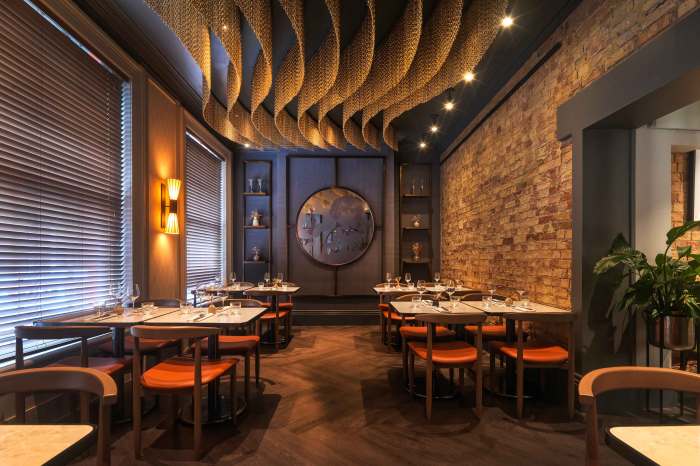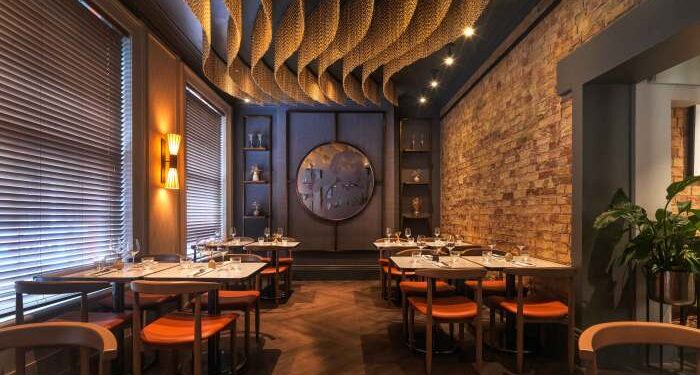Embark on a journey into the world of restaurant interior design, where every detail plays a crucial role in shaping the dining experience. From the choice of colors to the layout of furniture, discover how these elements come together to create a captivating ambiance that leaves a lasting impression on customers.
Explore the different facets of restaurant interior design and unravel the secrets behind creating a space that not only looks aesthetically pleasing but also functions seamlessly to elevate the overall dining experience.
Importance of Restaurant Interior Design
Restaurant interior design plays a crucial role in creating a unique dining experience for customers. It goes beyond just aesthetics and significantly impacts the overall atmosphere and perception of a restaurant.
Setting the Ambiance
The interior design of a restaurant sets the tone and ambiance for diners as soon as they walk in. For example, a cozy and warm color scheme with soft lighting can create a relaxing and intimate atmosphere, perfect for a romantic dinner.
On the other hand, a vibrant and colorful design with energetic music might be more suited for a casual dining experience.
Enhancing Comfort and Functionality
Well-thought-out interior design elements such as comfortable seating, proper lighting, and efficient layout can enhance the comfort and functionality of a restaurant. For instance, comfortable seating encourages customers to stay longer, while good lighting can highlight food presentation and create a welcoming environment.
Building Brand Identity
The interior design of a restaurant plays a key role in reflecting its brand identity and values. A modern and sleek design may appeal to a younger audience looking for a trendy dining experience, while a rustic and cozy design may attract customers seeking a more traditional feel.
Elements of Effective Restaurant Interior Design
When it comes to creating a well-designed restaurant interior, several key elements play a crucial role in shaping the overall ambiance and functionality of the space. From lighting to color schemes, furniture, layout, and spatial arrangement, each element contributes to the overall dining experience for customers.
Lighting
Effective lighting is essential in setting the mood and ambiance of a restaurant. Whether it’s natural light streaming in during the day or strategically placed artificial lighting in the evening, the right lighting can enhance the dining experience. Soft, warm lighting can create a cozy atmosphere, while brighter lights may be more suitable for a fast-paced environment.
Color Schemes
The color palette chosen for a restaurant can greatly impact the overall feel of the space. Warm tones like reds, oranges, and yellows can stimulate appetite, while cooler tones like blues and greens can create a more calming atmosphere. It’s important to consider the psychology of color when selecting a color scheme for the restaurant interior.
Furniture
The furniture in a restaurant not only needs to be aesthetically pleasing but also comfortable and functional. The type of seating chosen should align with the overall theme and concept of the restaurant. From cozy booths to sleek, modern chairs, the furniture should complement the design and layout of the space.
Layout and Spatial Arrangement
The layout and spatial arrangement of a restaurant are crucial in optimizing flow and functionality. A well-thought-out floor plan can enhance the customer experience by ensuring smooth traffic flow, providing privacy where needed, and maximizing seating capacity. The placement of tables, bar area, kitchen, and restrooms all play a role in creating a comfortable and efficient dining environment.
Trends in Restaurant Interior Design
Restaurant interior design is constantly evolving to meet the changing needs and preferences of diners. Let’s explore some of the current trends shaping the industry.
Sustainable Design
Sustainability is a key focus in modern restaurant interior design. From using eco-friendly materials to incorporating energy-efficient lighting, many restaurant owners are opting for sustainable design practices to reduce their environmental impact.
Minimalism and Simplicity
Minimalist design concepts are gaining popularity in restaurants, with clean lines, neutral colors, and uncluttered spaces creating a sense of calm and sophistication. Simple yet elegant interiors are appealing to customers seeking a more relaxed dining experience.
Mix of Textures and Materials
Contrasting textures and materials are being used creatively in restaurant interiors to add visual interest and depth. Combining elements like wood, metal, glass, and stone can create a dynamic and inviting atmosphere for diners.
Technology Integration
Modern restaurants are incorporating technology seamlessly into their interior design, with features like digital menus, interactive displays, and smart lighting systems. These tech-savvy additions enhance the overall dining experience and cater to a more digitally connected clientele.
Cultural Influences
Many restaurants are drawing inspiration from different cultures and traditions to create unique and immersive dining spaces. From Moroccan-inspired decor to Japanese aesthetic elements, incorporating cultural influences can add flair and authenticity to the overall design.
Sustainability in Restaurant Interior Design

Integrating sustainable practices into restaurant interior design is crucial for reducing environmental impact, promoting a healthier indoor environment, and appealing to eco-conscious customers.
Examples of Eco-friendly Materials and Design Choices
When designing a restaurant with sustainability in mind, there are several eco-friendly materials and design choices to consider:
- Using reclaimed wood for furniture and decor items
- Opting for energy-efficient lighting fixtures
- Choosing low VOC paints and finishes to improve indoor air quality
- Incorporating recycled materials into the design scheme
How Sustainability Enhances Aesthetics and Appeal
Sustainability can actually enhance the overall aesthetic and appeal of a restaurant by creating a unique and inviting atmosphere. For example, incorporating living green walls or vertical gardens not only adds a touch of nature but also improves air quality.
Additionally, showcasing sustainable design elements can attract environmentally-conscious customers who appreciate the eco-friendly approach.
Branding Through Interior Design
Interior design plays a crucial role in reflecting a restaurant’s brand and identity. It goes beyond just aesthetics and decor, as it can convey the essence of the restaurant’s values, vision, and overall concept to customers. Through strategic design choices, restaurants can create a unique and memorable experience that aligns with their brand.Decor, signage, and branding elements are key components in conveying a cohesive message that reinforces the restaurant’s brand.
From the color scheme and furniture selection to the layout and lighting, every aspect of the interior design should work together to communicate the brand’s personality and create a strong visual identity.
Role of Decor in Branding
- Decor elements such as artwork, furniture, and lighting can help establish the desired ambiance and style that reflects the brand’s identity.
- Choosing materials, textures, and patterns that resonate with the brand’s values can create a cohesive and immersive experience for customers.
- Consistency in decor across all touchpoints, including the dining area, restrooms, and even packaging, can strengthen brand recognition and loyalty.
Signage and Branding Elements
- Strategic placement of signage with the logo, tagline, or brand colors can enhance brand visibility and create a lasting impression on customers.
- Branding elements such as menu designs, uniforms, and table settings should align with the overall brand image to reinforce brand identity.
- Personalized and unique branding elements can set a restaurant apart from competitors and leave a memorable mark on customers.
Examples of Successful Branding Strategies
- Chipotle Mexican Grill’s use of sustainable materials and earthy tones in their interior design to reflect their commitment to fresh, organic ingredients and environmental responsibility.
- Starbucks’ consistent use of the green color scheme, logo placement, and cozy atmosphere to convey a sense of familiarity, comfort, and community.
- In-N-Out Burger’s classic red and white color palette, simple decor, and iconic branding elements that embody their no-frills, quality-focused approach to fast food.
Outcome Summary
In conclusion, restaurant interior design is far more than just aesthetics – it’s about setting the stage for memorable dining moments. By understanding the importance of various design elements and staying abreast of the latest trends, restaurants can create spaces that resonate with their customers and enhance their brand identity.
Quick FAQs
How does interior design influence the dining experience?
Interior design affects the atmosphere, comfort, and overall feel of a restaurant, directly impacting how customers perceive their dining experience.
What are some key elements of effective restaurant interior design?
Key elements include lighting, color schemes, furniture, layout, and spatial arrangement, all working together to create a cohesive ambiance.
Why is sustainability important in restaurant interior design?
Sustainability not only promotes eco-friendly practices but also enhances the aesthetic appeal of a restaurant, attracting environmentally conscious customers.














